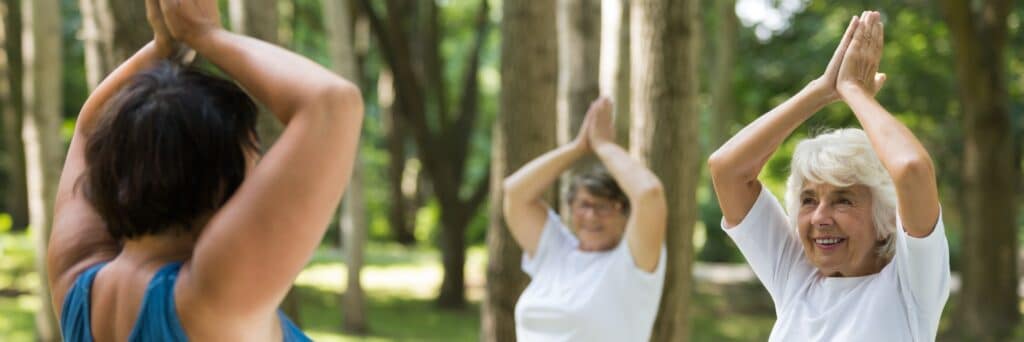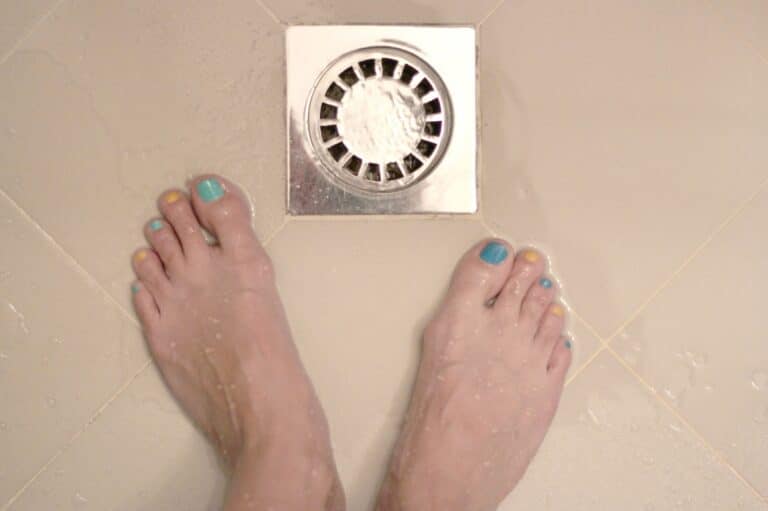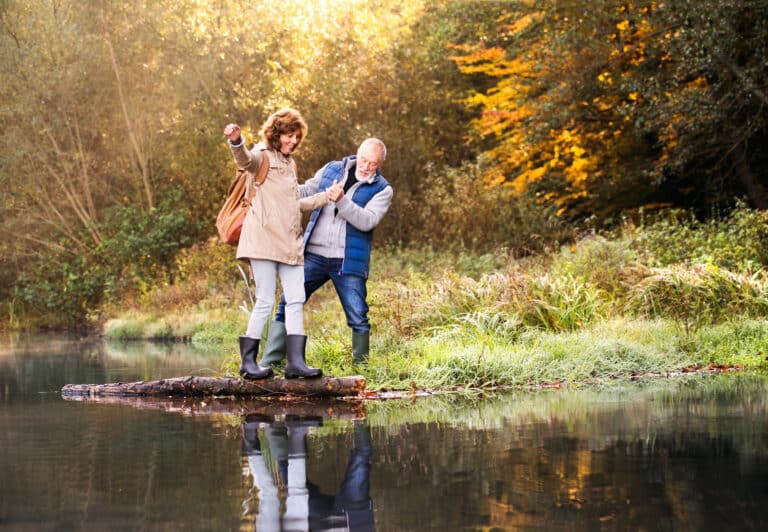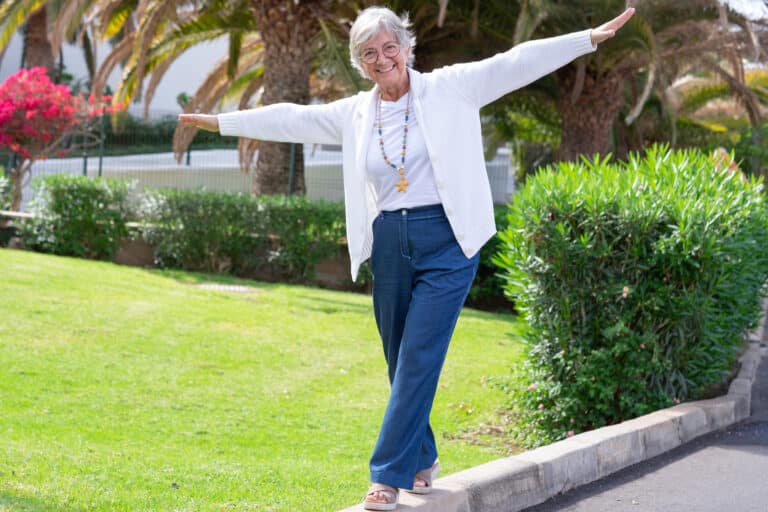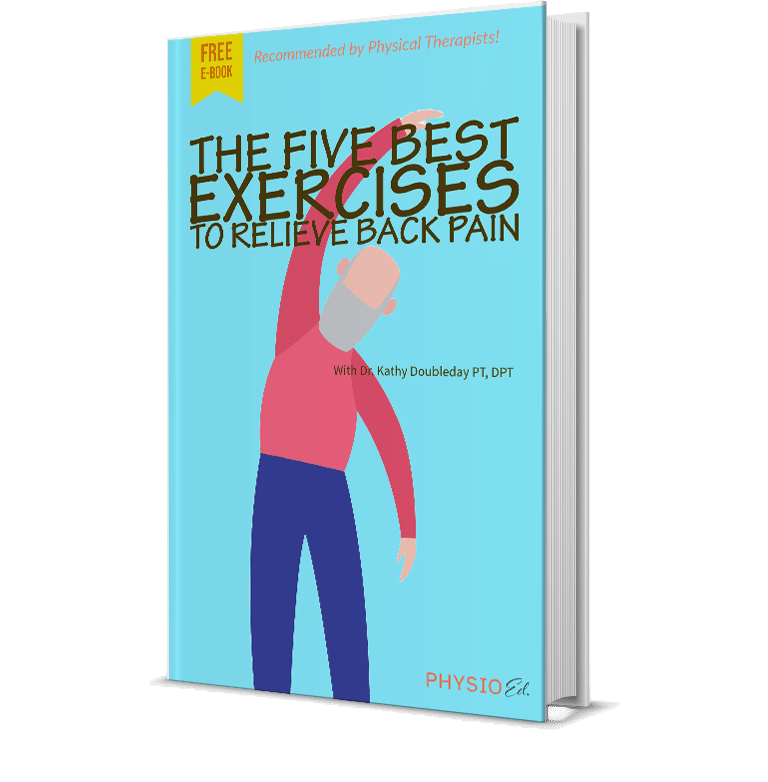Poor balance is a significant risk factor for older adult falls, which can lead to serious injury. In fact, one-third of adults over sixty-five will fall once a year.
Fortunately, fall prevention for seniors can be as simple as practicing a couple of fundamental exercises in the safety of your home.
Why Is There An Increased Risk of Falling With Age?
Poor postural control is a primary risk factor that increases the chance of falls for many older adults. Postural control requires coordination between several parts of your brain and body; it is not only limited to muscular strength.
Age can contribute to limited vision and depth perception, making it difficult to see potential fall hazards. As we age, the structures in our ears that help us balance can also be affected, causing problems like vertigo or difficulty maintaining balance.
These factors, combined with decreased lower extremity strength and sensation, also increase the risk of falling in older adults. According to the Centers for Disease Control and Prevention, 95% of hip fractures are caused by falls in older adults, primarily due to these common age-related conditions.
Fortunately, an at-home practice of fall prevention strategies and simple exercises can lessen risk factors related to aging.
Testing Balance at Home to Prevent Future Falls
There are a few ways to test balance at home. Keep a chair or countertop nearby to steady yourself, and feel free to use a cane, walker, or any other assistive devices that help you feel safe. Please remember that it’s normal to feel a little unsteady. Still, if you feel unsafe, consult your doctor or physical therapist before starting this or any other exercise program.
Narrow Stance Balance Test – Stand with your feet together with your arms folded across your chest. Take several deep breaths and try to hold this position for one minute or more.
Balance Beam Stance – Position your left foot directly in front of your right, heel-to-toe. Again, breathe deeply, do your best to relax, and aim for 30-40 seconds on each side.
Single Leg Balance Test – Stand on one foot and bend your opposite knee, lifting it off the floor with your eyes open. Start this test with your hands on a stable surface, and gradually remove your hands. Try to complete a twenty-second hold on each leg.
We encourage you to remember standing on one foot is challenging for most people. If you struggle with one or all of these tests, continue to practice. Next, we’ll look at a group of exercises to help you improve balance to prevent falls.
Exercises to Improve Balance and Prevent Fall Injuries
We have put together a short list of some of our favorite exercises to get you started on your fall prevention journey. Here are a few simple exercises to prevent falls and keep you moving:
Supported single-leg balance
We touched on this test previously, but we’d encourage you to work on it as much as possible. In this case, it will serve as a warm-up for your fall prevention program.
Hold on to a countertop or sturdy chair.
Slowly lift one foot off the floor and hold for as long as possible without putting your foot down.
As you improve, you can try standing on an unstable surface, such as a folded blanket, or close your eyes.
Remember not to hold your breath, and the risk of falls increases on an uneven surface, so be sure you have something you can rely on for support.
Walking the Line
This exercise will challenge your balance as you move.
Place a piece of masking tape on your floor, about eight-to-ten feet in length
Start with one foot at the end of the tape, and place your other foot in line, heel-to-toe.
‘Walk the line’ slowly, then turn around and walk back. If ‘walking the line’ feels too challenging, just walk with your feet slightly narrower than usual.
Sit-to-Stand
Sit upright in a sturdy chair, and take a few deep breaths. Take a moment to feel your feet on the ground, and take a few deep breaths.
From a seated position, carefully stand up, feeling the pressure of your feet flat on the floor, driving up to a tall standing posture.
Carefully sit back down, focusing on the sensations in your feet and legs. Complete this exercise slowly for eight-to-twelve repetitions, and rest as needed.
Heel Taps
This exercise challenges your balance and builds strength in the knees and upper legs.
Start standing with your hands on your hips, and lift one foot off the floor. Feel free to use a light hand on a table or chair for added support
Bend the standing leg slightly, and reach your lifted heel forward to tap the floor about a foot in front of the standing leg.
Repeat twelve repetitions on one leg, then switch. As you improve, you can keep both hands on your waist or even stand on a folded towel for an added balance challenge.
Slow Squat with a Hold
This exercise will help to build strength, muscle mass, and body awareness in the whole lower body:
Stand with your feet shoulder-width apart, and bend at your knees and hips as if preparing to sit on a tall chair.
Once you feel like the depth is challenging the muscles in your legs, hold that position and take three deep breaths. Focus on really feeling the muscles in your legs. Note: it is unnecessary to go especially low, as the main challenge in this exercise is holding the position.
Aim to perform two to three sets of eight squats, with a three-to-five-second hold for each repetition, and rest between sets.
Group Activities
There are a variety of exercises that can be beneficial both for your balance and to help you interact with other seniors and community members. Check your local fitness facility for tai chi, gentle yoga, or even dance classes to help add variety to your workouts.
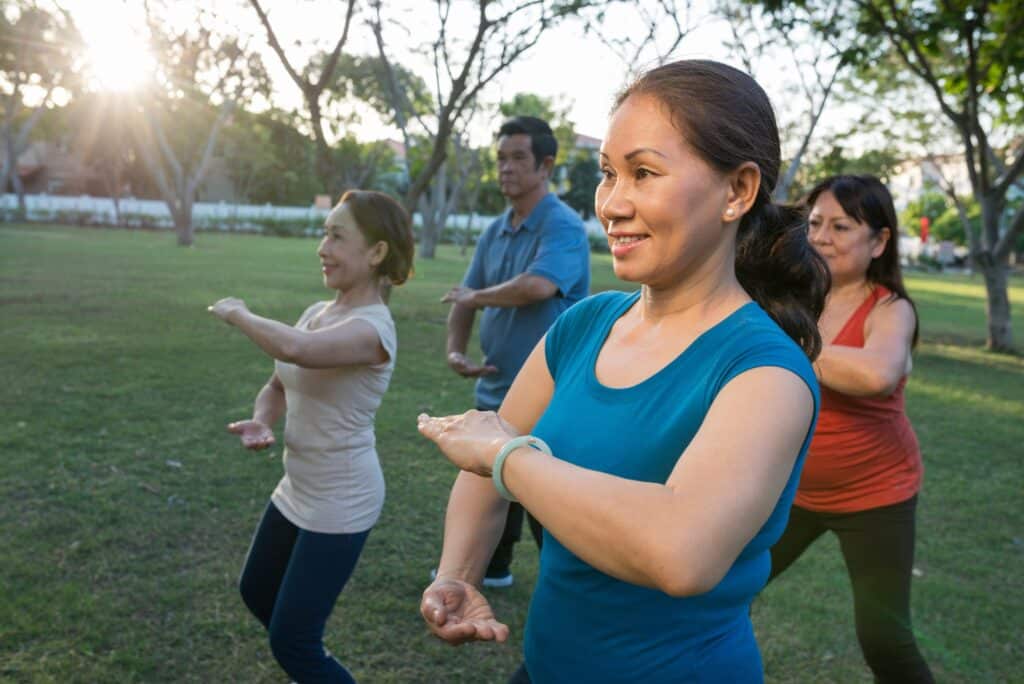
If you’re seeking more in-depth exercises, consider consulting a physical therapist specializing in fall prevention. Various clinics have specially designed fall prevention programs that can be individually tailored to your goals. For more severe balance problems, a physical therapist can help to get you back on track with the correct exercises to meet your goals.
Physio Ed also offers several online classes for older adults to combat fall risks.
Summary
Balance challenges that occur with aging can make performing everyday activities difficult. They can also lead to falls, negatively impacting the quality of life. Even a minor fall can lead to a higher risk of injury.
Engaging in simple fall prevention strategies and regular exercises can help improve balance and reduce the risk of falls, particularly for older adults.
If you occasionally struggle with balance, we hope the exercises mentioned above can help. Small doses of measured movements can help you regain your balance and confidence in everything you do in your busy life.
Sources
Hafström A, Malmström EM, Terdèn J, Fransson PA, Magnusson M. Improved Balance Confidence and Stability for Elderly After 6 Weeks of a Multimodal Self-Administered Balance-Enhancing Exercise Program: A Randomized Single Arm Crossover Study. Gerontol Geriatr Med. 2016 Apr 26;2:2333721416644149. doi: 10.1177/2333721416644149. PMID: 28138495; PMCID: PMC5119910.
https://www.cdc.gov/injury/features/older-adult-falls/index.html
Dunsky, A. (2019). The Effect of Balance and Coordination Exercises on Quality of Life in Older Adults: A Mini-Review. Frontiers in Aging Neuroscience, 11. https://doi.org/10.3389/fnagi.2019.00318
Thiamwong, L., & Suwanno, J. (2014). Effects of Simple Balance Training on Balance Performance and Fear of Falling in Rural Older Adults. International Journal of Gerontology, 8(3), 143-146. https://doi.org/10.1016/j.ijge.2013.08.011
FAQ
How do I improve my balance as I age?
Stay active. Regular physical activity can help you maintain your muscle strength, coordination, and reflexes. You can try walking, biking, swimming, or any other activity that you enjoy.
– Do balance exercises. You can practice standing on one leg, walking heel-to-toe, or doing yoga or tai chi. These exercises can improve your stability and posture.
– Check your medications. Some medications can cause dizziness or affect your balance. Talk to your doctor if you notice any side effects from your medications.
– Get your eyes checked. Vision problems can make it harder to see obstacles or judge distances. Make sure you have regular eye exams and wear glasses or contacts if needed.
– Make your home safer. You can reduce the risk of falling by removing clutter, securing rugs, installing grab bars, and using good lighting.
By following these tips, you can improve your balance as you age and enjoy a healthier and more independent life.
Why do older adults fall more?
– Changes in vision, hearing, balance, and reflexes
– Muscle weakness and joint stiffness
– Chronic conditions such as diabetes, arthritis, and osteoporosis
– Medications that affect alertness, coordination, or blood pressure
– Environmental hazards such as slippery floors, loose rugs, poor lighting, and clutter
Some of these factors can be prevented or managed with proper care and attention.
What type of exercises are best for improving balance?
The most effective programs will feature low-intensity strength training combined with balance exercises.

